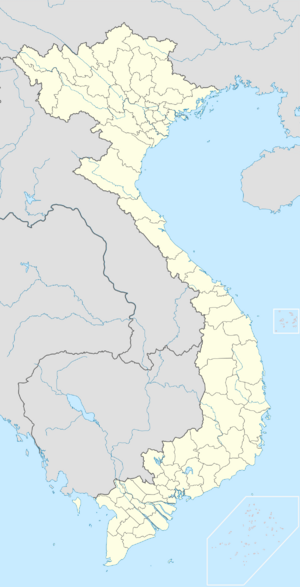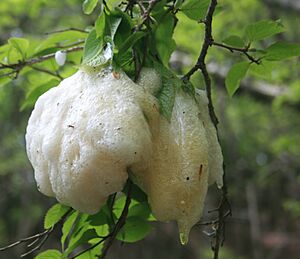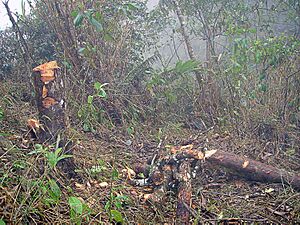Vampire tree frog facts for kids
Quick facts for kids Vampire tree frog |
|
|---|---|
| Conservation status | |
| Scientific classification | |
| Synonyms | |
|
Rhacophorus vampyrus Rowley, Le, Tran, Stuart, and Hoang, 2010 |
The Vampire tree frog (scientific name: Vampyrius vampyrus) is a special kind of flying frog. It lives only in southern Vietnam. This frog is known for its unique name because its baby tadpoles have tiny, fang-like hooks in their mouths!
These frogs live in mountain evergreen forests, high up in the trees. They are amazing at climbing and gliding. Their webbed feet help them "fly" or glide between trees. This is why they are sometimes called the vampire flying frog. Scientists sometimes use the name Rhacophorus vampyrus for this frog too.
Contents
About the Vampire Tree Frog
How the Vampire Tree Frog Got Its Name
The Vampire tree frog was first found in 2008. A scientist named Jodi Rowley and her student discovered it. They collected more frogs and officially described the new species in 2010.
At first, it was called Rhacophorus vampyrus. Later, scientists studied it more closely. They found it was quite different from other Rhacophorus frogs. So, in 2021, it was given its own special group, or genus, called Vampyrius. This is why its full scientific name is now Vampyrius vampyrus.
What Does the Vampire Tree Frog Look Like?
The Vampire tree frog is a medium-sized frog. It can grow to about 4.5 centimeters (about 1.8 inches) long. Its back is a pale copper-brown color. It often has lighter, dark-brown spots.
The frog's chest and belly are white. Its arms and legs are also copper-brown. The hands and feet fade to a pinkish-cream color. The webbing between its toes is dark grey or black. This webbing is super important for its "flying." Its eyes have bright yellow or gold irises with a little blue ring.
Vampire Tree Frog Tadpoles
The tadpoles of the Vampire tree frog are very special. They have unique black, hard hooks in their mouths. These look like tiny fangs! Their bodies are oval-shaped. They have long, flat tails. Young tadpoles are pale white or grey. As they grow, they turn a darker brown. Their eyes are black with gold specks.
Where Vampire Tree Frogs Live
The Vampire tree frog is only found in southern Vietnam. Scientists first found them in Bidoup Núi Bà National Park. They have also been seen in Ta Dung Nature Reserve.
These frogs need to live in moist, dense mountain rainforests. Their total living area is about 2,082 square kilometers (about 800 square miles). Sadly, their habitat is shrinking. This is because of things like cutting down trees.
Life Cycle of the Vampire Tree Frog
How Vampire Tree Frogs Reproduce
Vampire tree frogs lay their eggs in small, water-filled holes in trees. They usually lay eggs during the rainy season. These holes are typically about 0.3 to 1.2 meters (1 to 4 feet) above the ground.
Reproduction mostly happens from July to May. A female frog can lay up to 250 eggs at a time. The eggs are laid in a foam nest on the side of the tree hole. These nests are usually 30 to 120 centimeters (1 to 4 feet) above the ground.
When the eggs hatch, the tiny larvae (tadpoles) fall into the water below. The eggs are white and very small, about 0.7 to 1.3 millimeters wide.
What Vampire Tree Frog Tadpoles Eat
The unique "fangs" of the tadpoles are for eating. These tadpoles are special because they only eat eggs. The mother frog lays extra unfertilized eggs in the water hole just for her babies to eat. This is a great example of parental care!
The tadpoles have a wide mouth. This helps them eat larger eggs, even with their jelly coating. They also have a special pouch in their intestine. This pouch can expand to hold many eggs. It shrinks when they haven't eaten for a while.
Protecting Vampire Tree Frogs
Threats to Vampire Tree Frogs
The Vampire tree frog is an endangered species. This means it is at high risk of disappearing forever. One big problem is that its populations are separated. There are areas of low elevation between them that the frogs cannot cross. This makes it hard for them to find new mates.
These frogs need very specific moist, dense mountain rainforests to survive. But these forests are being destroyed. Deforestation (cutting down trees) is a major threat. Other activities like farming, especially for coffee beans, also harm their habitat. Building roads can also damage their homes. Since they live in trees and lay eggs in tree holes, losing trees is a huge danger to them.
Efforts to Help Vampire Tree Frogs
Luckily, the Vampire tree frog is found in protected areas. These include Bidoup-Nui National Park and Ta Dung Nature Reserve. Scientists think they might also live in other protected parks.
However, there is not much information about this species. More research is needed to understand them better. Scientists need to study their habitat, how many there are, and their behavior. This information will help create better plans to protect them. So far, these frogs have not been moved to new areas or kept in zoos for conservation.





